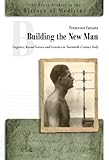Building the New Man : Eugenics, Racial Science and Genetics in Twentieth-Century Italy / Francesco Cassata.
Material type: TextSeries: CEU Press Studies in the History of MedicinePublisher: Budapest ; New York : Central European University Press, [2022]Copyright date: ©2011Description: 1 online resource (438 p.)Content type:
TextSeries: CEU Press Studies in the History of MedicinePublisher: Budapest ; New York : Central European University Press, [2022]Copyright date: ©2011Description: 1 online resource (438 p.)Content type: - 9789639776890
- 363.9/2
- HQ755.5.I8.C3713 2011eb
- online - DeGruyter
| Item type | Current library | Call number | URL | Status | Notes | Barcode | |
|---|---|---|---|---|---|---|---|
 eBook
eBook
|
Biblioteca "Angelicum" Pont. Univ. S.Tommaso d'Aquino Nuvola online | online - DeGruyter (Browse shelf(Opens below)) | Online access | Not for loan (Accesso limitato) | Accesso per gli utenti autorizzati / Access for authorized users | (dgr)9789639776890 |
Frontmatter -- Contents -- Acknowledgements -- Introduction -- CHAPTER I. Between Lombroso and Pareto : the Italian Way to Eugenics -- CHAPTER II. Eugenics and Dysgenics of War -- CHAPTER III. Regenerating Italy (1919–1924) -- CHAPTER IV. Quality through Quantity: Eugenics in Fascist Ital y -- CHAPTER V. Eugenics and Racism (1938–1943) -- CHAPTER VI. Toward a New Eugenics -- CHAPTER VII. Against UNESCO: Italian Eugenics and America n Scientific Racism -- Conclusions -- Bibliography -- Index of Names
restricted access online access with authorization star
http://purl.org/coar/access_right/c_16ec
Based on previously unexplored archival documentation, this book offers the first general overview of the history of Italian eugenics, not limited to the decades of Fascist regime, but instead ranging from the beginning of the 1900s to the first half of the 1970s. Discusses several fundamental themes of the comparative history of eugenics: the importance of the Latin eugenic model; the relationship between eugenics and fascism; the influence of Catholicism on the eugenic discourse and the complex links between genetics and eugenics. It examines the Liberal pre-fascist period and the post-WW2 transition from fascist and racial eugenics to medical and human genetics. As far as fascist eugenics is concerned, the book provides a refreshing analysis, considering Italian eugenics as the most important case-study in order to define Latin eugenics as an alternative model to its Anglo-American, German and Scandinavian counterparts. Analyses in detail the nature-nurture debate during the State racist campaign in fascist Italy (1938–1943) as a boundary tool in the contraposition between the different institutional, political and ideological currents of fascist racism.
Mode of access: Internet via World Wide Web.
In English.
Description based on online resource; title from PDF title page (publisher's Web site, viewed 29. Jul 2022)


